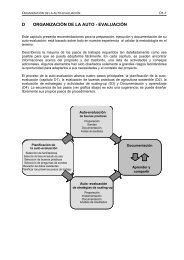cases from tanzania - Sustainet
cases from tanzania - Sustainet
cases from tanzania - Sustainet
You also want an ePaper? Increase the reach of your titles
YUMPU automatically turns print PDFs into web optimized ePapers that Google loves.
4 Agricultural policy in Kenya and Tanzania<br />
Sustainable agriculture solutions Sustainable agriculture offers various solutions to the<br />
problem of free grazing. It creates awareness among farmers of the negative impacts of this<br />
practice, and encourages them to reduce their livestock numbers or to feed them in other<br />
ways (tethering, stall-feeding). It provides other strategies to earn money, so reducing reliance<br />
on animals. It encourages the participatory planning of land use within the community to<br />
resolve conflicts between farmers and livestock keepers.<br />
Policy changes needed Policy changes include the following:<br />
• Strengthen and enforce by-laws to stop free grazing.<br />
• Encourage destocking by promoting other ways to make money.<br />
• Design marketing strategies to encourage farmers to sell their livestock at a young age.<br />
• Encourage farmers to keep their savings in the bank rather than in the form of livestock.<br />
• Promote the improvement of indigenous breeds so that fewer livestock are needed for<br />
the same output.<br />
• Allocate grazing areas to livestock keepers, and encourage farmers who keep livestock<br />
to fence their land to keep their animals away <strong>from</strong> their crop fields.<br />
infrastructure and services<br />
Infrastructure has greatly deteriorated since the reforms of the 1990s, and government<br />
expenditure on this sector dropped <strong>from</strong> 63% in 1999 to 54% in 2001. The poor state of<br />
transport, communication, storage facilities and irrigation schemes in rural Kenya and Tanzania<br />
stands out as one of the principal obstacles to agricultural production and marketing.<br />
Adequate investment in infrastructure and its efficient use are crucial if farming is to be<br />
productive and competitive. Poor infrastructure hinders access to services such as credit,<br />
extension, health and education and market information.<br />
Water is a key limiting factor. Except in the highland areas of western Kenya, most farming<br />
depends greatly on unreliable seasonal rainfall. Northern and eastern Kenya, and eastern and<br />
central Tanzania, are relatively dry. Farming is increasingly exposed to climatic extremes, with<br />
drought alternating with floods. For instance, a severe drought in 1999–2000 compounded<br />
Kenya’s problems, causing water and energy rationing and reducing agricultural output.<br />
Irrigation can provide significant increases in productivity and allow farmers to diversify into<br />
higher value products. While considerable potential exists for expanding irrigation, realizing<br />
this potential will be difficult. Large-scale irrigation schemes are expensive and inappropriate<br />
for small-scale farmers, particularly if staple food crops are grown. Kenya and Tanzania lack<br />
well-developed, locally appropriate means of small-scale irrigation to supplement rainfed agriculture.<br />
The irrigation infrastructure is thin and covers only 4–6% of the total arable land.<br />
Roads, transport and communication, storage and processing facilities are among the most<br />
important physical infrastructure for public as well as private investment. Governments have<br />
long focused on providing such services in and around urban areas, to the neglect of remote<br />
rural regions. Few traders reach villages and small towns. Unless the rural road coverage is<br />
increased significantly, farmers will remain seriously constrained by transport and information<br />
for their inputs and supplies, as well as in their ability to deliver produce to markets.<br />
103




